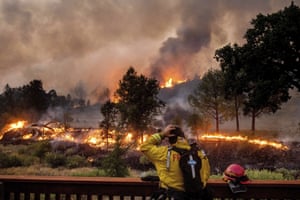Extract from The Guardian
- Forecasters issued a warning for Sunday morning through Monday night
- Blazes have burned more than 900,000 acres over seven days
- Area bigger than Rhode Island burns as resources stretched
- Farmworkers pick pay over health despite smoke-filled air
Already battling some of the largest wildfires on record, California is bracing for dry lightning and gusty winds that threaten to start more fire, and stoke the existing blazes.
The state has already requested help from Australia and Canada to help contain the fires , which have displaced more than 100,000 people and killed six and incinerated hundreds of homes. The blazes were sparked by an unusual barrage of lightning and stoked by a searing, persistent heatwave last week. Although cooler, more humid weather overnight helped firefighters make ground,
“we are not out of the woods”, said Cal Fire Unit chief Shana Jones on Saturday. “Upcoming predicted weather is not in our favor.”
The state’s governor, Gavin Newsom, said the fires,which have chewed through more than 991,000 acres over seven days, “are stretching our resources, our personnel”, requiring help from other states and countries.
Two fires, the LNU Lightning Complex and the SCU Lightning Complex, now rank as the second and third-largest on record.
“We simply haven’t seen anything like this in many, many years,” said Newsom, who has requested assistance from what he called “the world’s best wildfire-fighters” in Australia, a country that itself experienced enormous wildfires earlier this year.
Help from Canada and 10 other US states is also heading to California.
Some 560 wildfires were burning throughout the state on Saturday. Many were small and remote but the bulk of the damage was from three clusters ravaging forest and rural areas in the wine country and San Francisco Bay Area.

Those complexes, consisting of dozens of fires, exploded in size on Friday.
“What’s remarkable is that these fires are very explosive and they’re growing so quickly,” Crystal Kolden, a fire scientist at UC Merced, told the Guardian. Fires across the state are “becoming more frequent and more extreme with climate change”, she noted.
Forecasters have warned that things could get even dicier, issuing a red flag warning for Sundaymorning through Monday night. The National Weather Service warned of the potential for dry thunderstorms, noting that “lightning and gusty, erratic winds around storms will be the main threat”. The storms could not only start new fires, but also stoke the flames already burning through the state.
More than 12,000 personnel were fighting fires around the state, aided by helicopters and fixed-wing aircraft. By Friday, the state’s fire agency, Cal Fire, had called out 96% of available fire engines.
Among those beating back the flames are more than 1,300 incarcerated firefighters who have been entrusted with the backbreaking work of clearing the fire-fueling vegetation in exchange for low wages and reduced sentences. Their ranks have been diminished by devastating Covid-19 outbreaks in California prisons.
“Their labor has been exploited for decades,” Romarilyn Ralston, who leads Project Rebound, a California State University program that supports formerly incarcerated students, recently told the Guardian. “People are injured, sometimes not fully prepared for fighting a wildland fire.”
This week, the number of large fires was “staggering” and had put “tremendous strain” on resources not just in California, but throughout western states, said Sean Kavanaugh, Cal Fire incident commander. Nevada and Arizona, for example, battled sizable blazes this week as a heatwave swept the west.
In the Santa Cruz mountains south of San Francisco, about 1,000 firefighters were battling a fire 10 times the size they typically would cover, said Dan Olsen, a Cal Fire spokesman.

Three bodies were found on Thursday in a burned home in Napa county, said Henry Wofford, a sheriff’s spokesman.
A man died in neighboring Solano county, and a Pacific Gas & Electric utility worker was found dead in a vehicle in the Vacaville area. Also on Wednesday, a helicopter pilot died in a crash while dropping water on a blaze in Fresno county.
Smoke and ash billowing from the fires has fouled the air throughout the San Francisco Bay area and along California’s scenic central coast. Health officials, who have been advising residents that outdoor spaces are safer than indoors amid the coronavirus pandemic, said this week to stay inside.
Officials warned that air pollution, which has billowed all the way over to the Great Plains in the middle of the country, will render those with respiratory conditions, who face an elevated risk of complications from Covid-19, doubly vulnerable. Growing evidence also suggests that pollution might aggravate the spread of the virus, or worsen its toll.
The fires have also strained the state’s public health resources, already stretched by the struggle to contain a recent surge in coronavirus cases. And those who have been forced to flee their homes have had to weigh the risks of staying with friends and family, or at evacuation centers – where they risk exposure to the virus.
Agencies contributed reporting

No comments:
Post a Comment